Contents
SAVANNAH & THE GEORGIA COAST

Rarely has a city owed so much to the vision of one person than Savannah owes to General James Edward Oglethorpe. Given the mission by King George II of England to buffer Charleston from the Spanish, this reformer had a far more sweeping vision in mind. After befriending a local Creek people, Oglethorpe laid out his settlement in a deceptively simple plan that is still studied the world over as a model of nearly perfect urban design. Many of his other progressive ideassuch as prohibiting slavery and hard liquor, to name twosoon went by the wayside. But the legacy of his original plan lives on to this day.
Savannah was built as a series of rectangular wards, each built around a central square. As the city grew, each square took on its own characteristics, depending on who lived on the square and how they made their livelihood. It is this individuality that is so well documented in John Berendts Midnight in the Garden of Good and Evil. The squares of Savannahs downtownsince 1965 a National Landmark Historic Districtare also responsible for the citys walkability, another defining characteristic. Just as cars entering a square must yield to traffic already within, pedestrians are obliged to slow down and interact with the surrounding environment, both constructed and natural. You become participant and audience simultaneously, a feat made easier by the local penchant for easy conversation.


LOOK FOR  TO FIND RECOMMENDED SIGHTS, ACTIVITIES, DINING, AND LODGING.
TO FIND RECOMMENDED SIGHTS, ACTIVITIES, DINING, AND LODGING.
 River Street: Despite River Streets tourist tackiness, theres still nothing like strolling the cobblestones amid the old cotton warehouses, enjoying the cool breeze off the river, and watching the huge ships on their way to and from the bustling port ().
River Street: Despite River Streets tourist tackiness, theres still nothing like strolling the cobblestones amid the old cotton warehouses, enjoying the cool breeze off the river, and watching the huge ships on their way to and from the bustling port ().
 First African Baptist Church: The oldest black congregation in the United States still meets in this historic sanctuary, a key stop on the Underground Railroad ().
First African Baptist Church: The oldest black congregation in the United States still meets in this historic sanctuary, a key stop on the Underground Railroad ().
 Owens-Thomas House: Possibly the countrys best example of Regency architecture and definitely an example of state-of-the-art historic preservation in action, this is Savannahs single greatest historical home ().
Owens-Thomas House: Possibly the countrys best example of Regency architecture and definitely an example of state-of-the-art historic preservation in action, this is Savannahs single greatest historical home ().
 Telfair Museums: Old school meets new school in this museum complex that comprises the traditional collection of the Telfair Academy of Arts and Sciences and the ultramodern Jepson Center for the Arts, both within a stones throw of each other ().
Telfair Museums: Old school meets new school in this museum complex that comprises the traditional collection of the Telfair Academy of Arts and Sciences and the ultramodern Jepson Center for the Arts, both within a stones throw of each other ().
 Cathedral of St. John the Baptist: This soaring Gothic Revival edifice is complemented by its ornate interior and its matchless location on verdant Lafayette Square, stomping ground of the young Flannery OConnor ().
Cathedral of St. John the Baptist: This soaring Gothic Revival edifice is complemented by its ornate interior and its matchless location on verdant Lafayette Square, stomping ground of the young Flannery OConnor ().
 Monterey Square: Perhaps Savannahs quintessential square, with some of the best examples of local architecture and world-class ironwork all around its periphery ().
Monterey Square: Perhaps Savannahs quintessential square, with some of the best examples of local architecture and world-class ironwork all around its periphery ().
 Forsyth Park: A verdant expanse ringed with old live oaks, with chockablock memorials. The true center of downtown life, it is Savannahs backyard ().
Forsyth Park: A verdant expanse ringed with old live oaks, with chockablock memorials. The true center of downtown life, it is Savannahs backyard ().
 Bonaventure Cemetery: This historic burial ground is the final resting place for some of Savannahs favorite citizens, including the great Johnny Mercer, and makes great use of its setting on the banks of the Wilmington River ().
Bonaventure Cemetery: This historic burial ground is the final resting place for some of Savannahs favorite citizens, including the great Johnny Mercer, and makes great use of its setting on the banks of the Wilmington River ().
 Fort Pulaski National Monument: This well-run site, built with the help of a young Robert E. Lee, is not only historically significant, its beautiful setting makes it a great place for the entire family ().
Fort Pulaski National Monument: This well-run site, built with the help of a young Robert E. Lee, is not only historically significant, its beautiful setting makes it a great place for the entire family ().
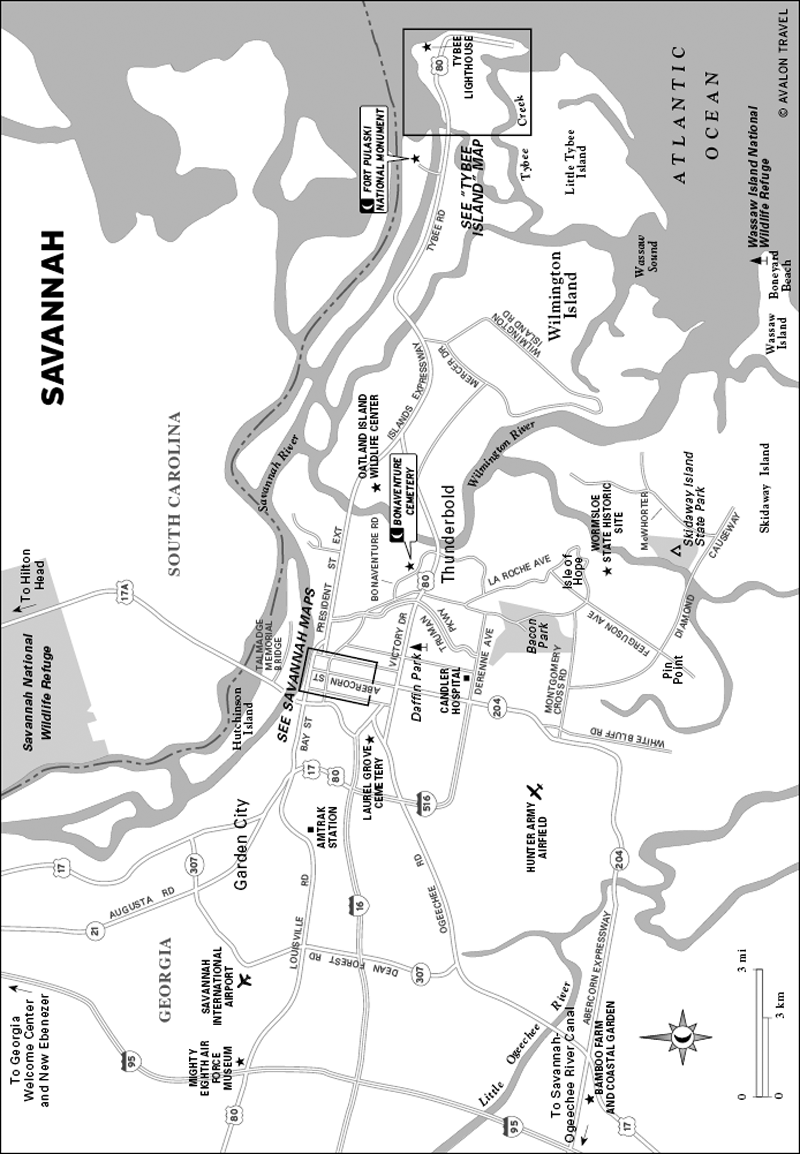
In an increasingly homogenized society, Savannah is one of the last places left where eccentricity is celebrated and even encouraged. This outspoken, often stubborn determination to make ones own way in the world is personified by the old Georgia joke about Savannah being the capital of the state of Chatham, a reference to the county in which it resides. In typical contrarian fashion, Savannahians take this nickname, ostensibly a pejorative, as a compliment.
Savannah is also known for being able to show you a rowdy good time, and not only during its massive, world-famous St. Patricks Day celebration. Savannahians, like New Orleanians, will use any excuse for a party, and any excuse to drink in the full flavor of natural beauty herewhether in the heady glory of a spring day with all the flowers blooming, or the sweet release of the long-awaited autumn, brisk and bracing but not so crisp that you cant wear shorts.
While Charlestons outlying areas tend to complement the history and outlook of the Holy City itself, Savannahs outskirts are more self-contained. Despite the fact that Tybee Island is largely dependent on Savannahs economy, it has willfully kept its own fun and funky persona. More rural areas outside town, such as New Ebenezer and Midway, are reflective of a wholly different side of the statea Georgia of country churches and tight-knit descendants of original plantation owners.
To understand the inferiority complex that Savannah feels with regards to Charleston, you have to remember that literally from day one, Savannah was intended to play second fiddle to its older, richer neighbor to the north. By the early 1700s, the land south of Charleston was a staging area for attacks by the Spanish and Native Americans. So in 1732, King George II granted a charter to the Trustees of Georgia, a proprietary venture that was the brainchild of a 36-year-old general and member of parliament, General James Edward Oglethorpe. On February 12, 1733, the Anne landed with 114 passengers along the high bluff on the south bank of the Savannah River. Oglethorpe bonded with Tomochichi, the local Creek Indian chief, and the colony prospered. (Contrary to what locals might tell you, Savannah did not get its name because it resembles a grassy savanna. The city is named for the Savannah River, which itself is named for a wandering, warring offshoot of a local Shawnee people.)
Ever the idealist, Oglethorpe had a plan for the new classless society in Savannah that prohibited slavery, rum, andwait for itlawyers! But as the settlers enviously eyed the dominance of Charlestons slave-based rice economy, the Trustees bowed to public pressure and relaxed restrictions on slavery and rum. By 1753, the crown reclaimed the charter, making Georgia Americas 13th colony. Though part of the new United States in 1776, Savannah was captured by British forces in 1778, who held the city against a combined assault a year later. After the Revolution, Savannah became the first capital of Georgia, a role it had until 1786.

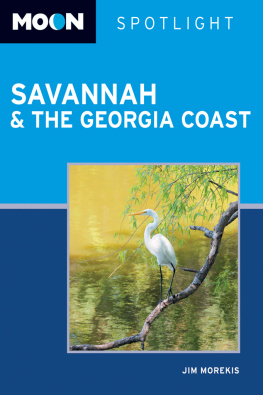
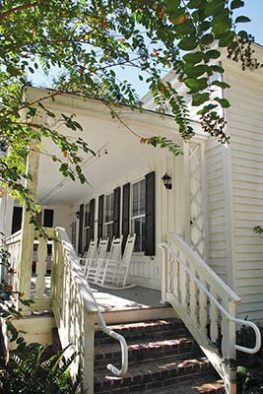
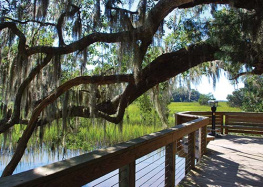

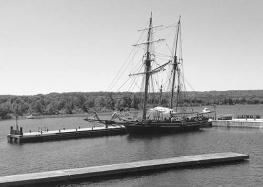


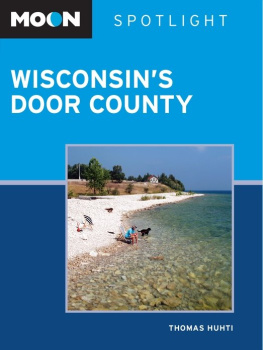



 TO FIND RECOMMENDED SIGHTS, ACTIVITIES, DINING, AND LODGING.
TO FIND RECOMMENDED SIGHTS, ACTIVITIES, DINING, AND LODGING.